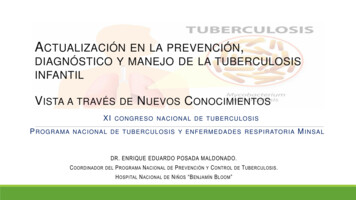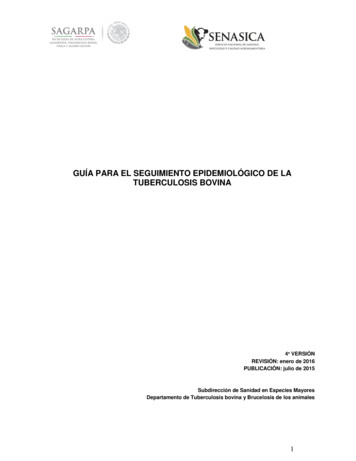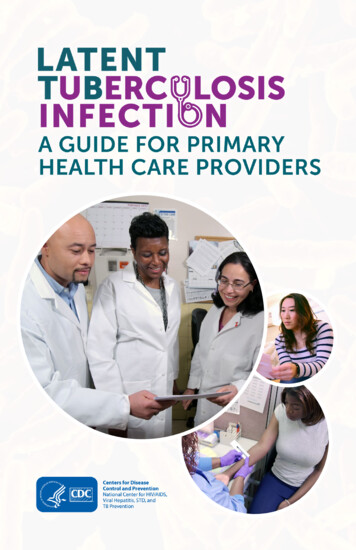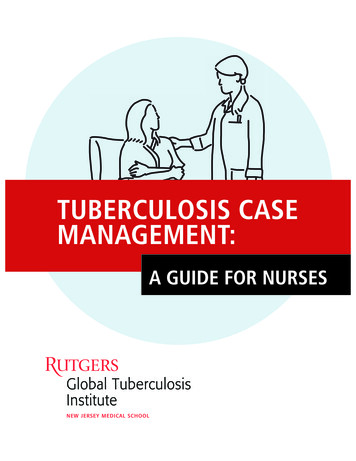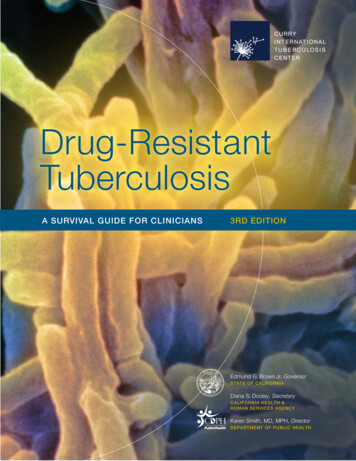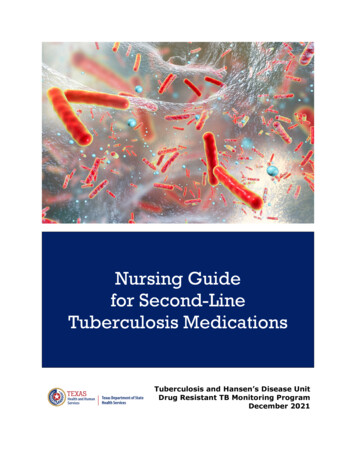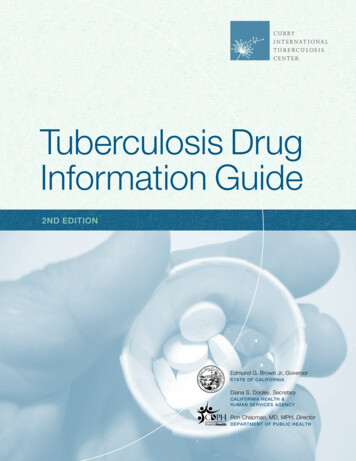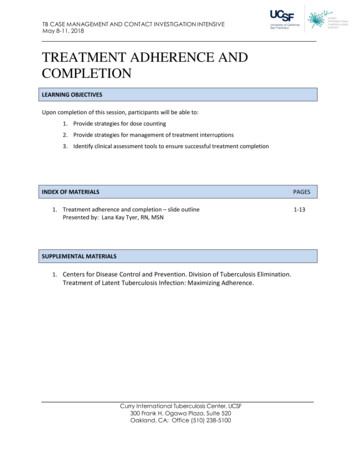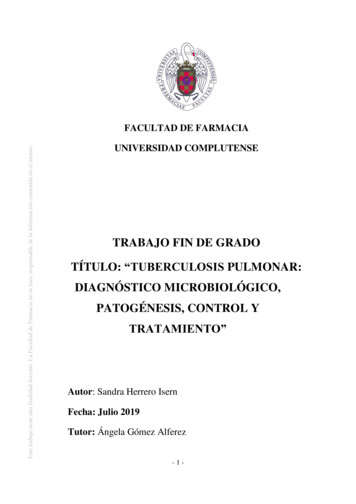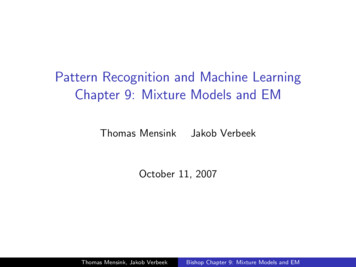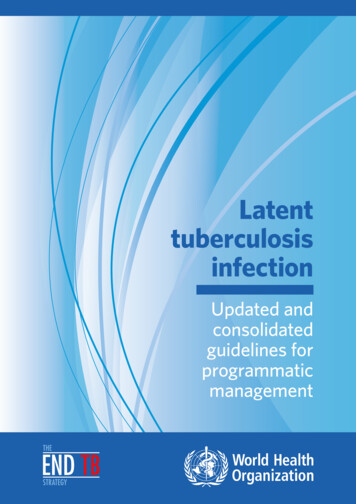
Transcription
LatenttuberculosisinfectionUpdated andconsolidatedguidelines forprogrammaticmanagement
Latent tuberculosis infectionUpdated and consolidated guidelines forprogrammatic management
Latent tuberculosis infection: updated and consolidated guidelines for programmatic managementISBN 978-92-4-155023-9 World Health Organization 2018Some rights reserved. This work is available under the Creative Commons Attribution-NonCommercial-ShareAlike3.0 IGO licence (CC BY-NC-SA 3.0 IGO; igo).Under the terms of this licence, you may copy, redistribute and adapt the work for non-commercial purposes, provided thework is appropriately cited, as indicated below. In any use of this work, there should be no suggestion that WHO endorsesany specific organization, products or services. The use of the WHO logo is not permitted. If you adapt the work, then youmust license your work under the same or equivalent Creative Commons licence. If you create a translation of this work,you should add the following disclaimer along with the suggested citation: “This translation was not created by the WorldHealth Organization (WHO). WHO is not responsible for the content or accuracy of this translation. The original Englishedition shall be the binding and authentic edition”.Any mediation relating to disputes arising under the licence shall be conducted in accordance with the mediation rules ofthe World Intellectual Property Organization.Suggested citation. Latent tuberculosis infection: updated and consolidated guidelines for programmatic management.Geneva: World Health Organization; 2018. Licence: CC BY-NC-SA 3.0 IGO.Cataloguing-in-Publication (CIP) data. CIP data are available at http://apps.who.int/iris.Sales, rights and licensing. To purchase WHO publications, see http://apps.who.int/bookorders. To submit requests forcommercial use and queries on rights and licensing, see http://www.who.int/about/licensing.Third-party materials. If you wish to reuse material from this work that is attributed to a third party, such as tables, figuresor images, it is your responsibility to determine whether permission is needed for that reuse and to obtain permission fromthe copyright holder. The risk of claims resulting from infringement of any third-party-owned component in the work restssolely with the user.General disclaimers. The designations employed and the presentation of the material in this publication do not imply theexpression of any opinion whatsoever on the part of WHO concerning the legal status of any country, territory, city orarea or of its authorities, or concerning the delimitation of its frontiers or boundaries. Dotted and dashed lines on mapsrepresent approximate border lines for which there may not yet be full agreement.The mention of specific companies or of certain manufacturers’ products does not imply that they are endorsed orrecommended by WHO in preference to others of a similar nature that are not mentioned. Errors and omissions excepted,the names of proprietary products are distinguished by initial capital letters.All reasonable precautions have been taken by WHO to verify the information contained in this publication. However, thepublished material is being distributed without warranty of any kind, either expressed or implied. The responsibility for theinterpretation and use of the material lies with the reader. In no event shall WHO be liable for damages arising from its use.WHO/CDS/TB/2018.4
ContentsAcknowledgementsvDeclaration and management of conflicts of interestviiAbbreviationsixDefinitionsxExecutive summary11.5Introduction2. Identification of populations for testing and treatment of latent tuberculosis infection 93. Algorithms for ruling out active tuberculosis disease144. Testing for latent tuberculosis infection215. Treatment options for latent tuberculosis infection236. Preventive treatment for contacts of patients with multidrug-resistant tuberculosis287. Issues in implementation308. Research priorities329. References34Annex 1. GRADE profile tables for new recommendations39Annex 2. Evidence-to-Decision and GRADE tables (online at www.who.int/tb)Annex 3. Survey on the values and preferences for the management of latent tuberculosisinfection (online at www.who.int/tb)CONTENTSiii
AcknowledgementsOverall coordination and writing of the guidelinesYohhei Hamada and Haileyesus Getahun coordinated the development and writing of the guidelines under theoverall direction of Mario Raviglione.WHO steering groupAndrei Dadu (TB and M/XDR-TB Programme, WHO Regional Office for Europe); Meg Doherty (HIVdepartment, WHO); Dennis Falzon (Global TB Programme, WHO); Nathan Ford (HIV department, WHO);Haileyesus Getahun (Global TB Programme, WHO); Christopher Gilpin (Global TB Programme, WHO);Malgorzata Grzemska (Global TB Programme, WHO); Yohhei Hamada (Global TB Programme, WHO);Andreas Reis (Information, Evidence and Research, WHO); Wilson Were (Department of Maternal, Newborn,Child and Adolescent Health, WHO).Co-chairs of the WHO Guidelines Development GroupAlberto Matteelli (University of Brescia, WHO Collaborative Centre for TB/HIV and TB Elimination, Italy) andNandi Siegfried (independent clinical epidemiologist, South Africa)GRADE methodologist for the WHO Guidelines Development GroupNandi Siegfried (independent clinical epidemiologist, South Africa).Members of WHO Guidelines Development GroupSi Thu Aung (National TB Programme, Department of Public Health, Ministry of Health, Myanmar);Rolando Cedillos (Service of Infectology and Integrated Programme for STI/HIV/AIDS, El Salvador); RichardChaisson (Center for TB Research, Johns Hopkins University, United States of America); PadmapriyadarsiniChandrasekaran (National Institute for Research in Tuberculosis, India); Lucy Chesire (TB AdvocacyConsortium, Kenya); Betina Durovni (Federal University of Rio de Janeiro, Brazil); Diana Gibb (MedicalResearch Council, United Kingdom of Great Britain and Northern Ireland); Stephen Graham (Centre forInternational Child Health, University of Melbourne, Australia); Sally Hargreaves (Imperial College London,United Kingdom); Diane Havlir (University of California, USA); Nguyen van Hung (National Lung Hospital,Viet Nam); Mohammed Al Lawati (Consultant Physician, Oman); Alberto Matteelli (University of Brescia,WHO Collaborative Centre for TB/HIV and TB Elimination, Italy); Lindiwe Mvusi (National Department ofHealth, South Africa); Nadia Ismail Abu Sabrah (consultant TB physician and epidemiologist, Jordan); Mariekevan der Werf (European Centre for Disease Prevention and Control, Sweden); Wim Vandevelde (Global TBCommunity Advisory Board, South Africa); Irina Vasilyeva (Ministry of Health, Russian Federation)ObserversAnand Date (Centers for Disease Control and Prevention, USA); Ya Diul Mukadi (US Agency for InternationalDevelopment [USAID], USA).ACKNOWLEDGEMENTSv
Systematic reviewersYalemzewed Assefa (University of Queensland, Australia); Yibeltal Assefa (University of Queensland,Australia); Ioana Diana Olaru (Borstel Research Centre, Germany); Darshini Govindasamy (South AfricanMedical Research Council, South Africa); Yohhei Hamada (Global TB Programme, WHO), Sandra Kik (KNCVTuberculosis Foundation, Netherlands); Katharina Kranzer (London School of Hygiene and Tropical Medicine,United Kingdom); Johnny Lujan (Global TB Programme, WHO); Molebogeng Xheedha Rangaka (UniversityCollege London, United Kingdom); Karl Schenkel (Global TB Programme, WHO); Solomon Woldeyohannes(University of Queensland, Australia).Peer reviewersSevim Ahmedov (USAID, USA); Taye Tolera Balcha (Armauer Hansen Research Institute, Ethiopia); AmyBloom (USAID, USA); Anne Detjen (UNICEF); Christine Ho (Centers for Disease Control and Prevention,USA); Sundari Mase (WHO Country Office, India); Michael Kimerling (KNCV Tuberculosis Foundation,Netherlands); Giovanni Battista Migliori (WHO Collaborating Centre for TB and Lung Diseases, Fondazione S.Maugeri, Italy); Zelalem Temesgen (Mayo Clinic, USA).Other contributorsLiani Smit (University of Stellenbosch and Western Cape Department of Health, South Africa) provided inputfor the survey of values and preferences; Enrico Girardi and Monica Sanè Schepisi (Istituto Nazionale MalattieInfettive L. Spallanzani, Italy) shared results from an updated systematic review of the cost-effectiveness oftesting and treatment for latent tuberculosis.WHO staff and consultantsGlobal TB Programme: Annabel Baddeley, Ernesto Jaramillo, Avinash Kanchar, Knut Lönnroth, Kefas Samson,Karin WeyerHIV department: Satvinder SinghFinancial supportPreparation of these guidelines was supported financially by the US Centers for Disease Control and Prevention,USAID and the Ministry of Health of the Republic of Korea.viLATENT TUBERCULOSIS INFECTION: UPDATED AND CONSOLIDATED GUIDELINES FOR PROGRAMMATIC MANAGEMENT
Declaration and managementof conflicts of interestAll the contributors completed a WHO declaration of interests form. All the declarations were evaluated bythree members of the Steering Group for any financial conflict of interest that might warrant exclusion frommembership of the Guidelines Development or Peer Review Group or from discussions during preparation ofthe guidelines. Intellectual conflict of interest was not considered a motive for exclusion from membershipof the Guidelines Development Group, as broad expertise on latent tuberculosis (TB) was considered acriterion for selection. In addition, the diversity and representation in the Group was considered large enoughto balance and overcome any potential intellectual conflict of interest. The biographies of the GDG memberswere made public before the meeting, in line with WHO’s policy on conflicts of interest. The completed formswere reviewed at the beginning of the meeting of the Guidelines Development Group, at which time memberscould update their declarations.Guidelines Development GroupThe following Guidelines Development Group members declared interests, which were judged to be in noconflict with the policy of WHO or the objectives of the meeting; none of the members declared commercialfinancial interests that were directly or indirectly related to the objectives of the meeting.Padmapriyadarsini Chandrasekaran declared that her employer received research grants for the ModelDOTS Project from USAID.Diana Gibb declared that she was coordinating a trial centre for the TB CHAMP trial, which is funded bythe Medical Research Council, the Department for International Development and the Wellcome Trust.Stephen Graham declared that he had received remuneration from the Challenge TB for providing technicalassistance in training and implementation of child contact screening and preventive therapy in Viet Nambetween 2012 and 2016. He is currently a co-investigator in the V-QUIN and received research grants fromthe National Health and Medical Research Council, Australia. He is also a co-principal investigator of theDETECT Child TB (child TB diagnosis, treatment and prevention) in Uganda and received research grantsfrom ELMA Philanthropies and the International Union Against Tuberculosis and Lung Disease.Diane Havlir declared that she received research support from National Institutes of Health for researchon TB.Marieke van der Werf declared that she was an employee of the European Centre for Disease Preventionand Control, which has an interest in the management of LTBI. She was an opponent in defense of a PhDthesis that included studies on LTBI and received a remuneration of DKK 6741.16.Wim Vandevelde declared that he was the chair of the Global TB Community Advisory Board on a voluntarybasis. He stated that he represented the interests and needs of communities affected by TB.The remaining members of the Group declared no conflicts of interests.External Review GroupThe following External Review Group member declared interests that were judged to be in no conflict with thepolicy of WHO:Michael Kimerling declared that his employer received grants for research on a 3-month regimen of weeklyrifapentine plus isoniazid from USAID and for implementation of the regimen from UNITAID.DECLARATION AND MANAGEMENT OF CONFLICTS OF INTERESTvii
The remaining members of the Group declared no conflicts of interests.Evidence reviewersThe researchers who did the systematic reviews of evidence (patients, intervention, comparator and outcomes,PICO) for these guidelines were:PICO 1: Darshini Govindasamy, South African Medical Research Council, South Africa; Katharina Kranzer,London School of Hygiene and Tropical Medicine, United Kingdom; and Ioana Diana Olaru, Borstel ResearchCentre, GermanyPICO 2: Yohhei Hamada, Johnny Lujan, and Karl Schenkel, Global TB Programme, WHOPICO 3: Yalemzewed Assefa, Yibeltal Assefa and Solomon Woldeyohannes, University of Queensland,AustraliaPICO 4: Sandra Kik, KNCV Tuberculosis Foundation, Netherlands, and Molebogeng Xheedha Rangaka,University College London, United KingdomPICO 5: Yalemzewed Assefa, Yibeltal Assefa and Solomon Woldeyohannes, University of Queensland,AustraliaPICO 6 and 7: Yohhei Hamada, and Karl Schenkel, Global TB Programme, WHOThese reviewers did not participate in formulating the recommendations for policy.The following reviewers declared interests that were judged not to be in conflict with the policy of WHO or theobjectives of the meeting:Darshini Govindasamy declared that her institution (South African Medical Research Council) and researchunit received grants from funders to conduct studies on TB.Katharina Kranzer declared that she was employed as a consultant to the national reference laboratory(Borstel Research Centre). Funding for her to speak at several German universities, Gilead, Thermo FisherScientific and Roche, was paid to her employer. None of these activities were considered to be a significantconflict of interests in view of the topic of the review and the nature of the work she did. Furthermore, thepresence of two other reviewers on the team, that selected papers and entered and analysed data, wouldovercome any potential conflict of interests.The other evidence reviewers declared no conflict of interests.All the declarations of interest are available as electronic file at the WHO Global Tuberculosis Programme.viiiLATENT TUBERCULOSIS INFECTION: UPDATED AND CONSOLIDATED GUIDELINES FOR PROGRAMMATIC MANAGEMENT
AbbreviationsARTantiretroviral treatmentBCGbacille Calmette-GuérinCIconfidence intervalGDGGuideline Development GroupGRADEgrading of recommendations assessment, development and evaluationIGRAinterferon-gamma release assayIPTisoniazid preventive therapy or treatmentLTBIlatent tuberculosis infectionMDR-TB multidrug-resistant tuberculosisPICOpatients, intervention, comparator and outcomesRCTrandomized controlled trialTSTtuberculin skin testTBtuberculosisABBREVIATIONSix
DefinitionsNote: The definitions listed below apply to the terms as used in these guidelines. They may have differentmeanings in other contexts.Adolescent: A person aged 10–19 yearsAdult: A person over 19 years of ageBacteriologically confirmed TB: TB diagnosed in a biological specimen by smear microscopy, culture or aWHO-approved molecular test such as Xpert MTB/RIFChild: A person under 10 yearsContact: Any person who was exposed to a case of TB (see definition below)Contact investigation: A systematic process for identifying previously undiagnosed cases of TB amongthe contacts of an index case. In some settings, the goal includes testing for LTBI to identify candidates forpreventive treatment. Contact investigation consists of identification and prioritization and clinical evaluation.High-TB-incidence country: A country with a WHO-estimated TB incidence rate of 100/100 000Household contact: A person who shared the same enclosed living space as the index case for one or morenights or for frequent or extended daytime periods during the 3 months before the start of current treatmentIndex case (index patient) of TB: The initially identified case of new or recurrent TB in a person of any age, ina specific household or other comparable setting in which others may have been exposed. An index case is thecase on which a contact investigation is centred but is not necessarily the source case.Infant: A child under 1 year of ageLatent tuberculosis infection (LTBI): A state of persistent immune response to stimulation by Mycobacteriumtuberculosis antigens with no evidence of clinically manifest active TB. There is no gold standard test for directidentification of Mycobacterium tuberculosis infection in humans. The vast majority of infected people have nosigns or symptoms of TB but are at risk for active TB disease.Low-TB-incidence country: Country with a WHO-estimated TB incidence rate of 100 per 100 000 populationPreventive treatment: Treatment offered to individuals who are considered to be at risk for TB disease in orderto reduce that risk. Also referred to as LTBI treatment or preventive therapyTuberculosis (TB): The disease state due to Mycobacterium tuberculosis. In this document, commonly referredto as “active” TB or TB “disease” in order to distinguish it from LTBIxLATENT TUBERCULOSIS INFECTION: UPDATED AND CONSOLIDATED GUIDELINES FOR PROGRAMMATIC MANAGEMENT
Executive summaryLatent tuberculosis infection (LTBI) is defined as a state of persistent immune response to stimulation byMycobacterium tuberculosis antigens with no evidence of clinically manifest active TB. There is no gold standardtest for LTBI. The WHO guidelines on LTBI consider the probability of progression to active TB disease in aspecific risk group, the epidemiology and burden of TB, the availability of resources and the likelihood of abroad public health impact. Two fragmented recommendations have been made for the management of LTBI,which resulted in a number of guideline documents, posing a challenge to implementation. Therefore, severalWHO Member States requested consolidated guidelines on LTBI management.The updated, consolidated guidelines in this document respond to that request. They provide a comprehensiveset of WHO recommendations for programmatic management of LTBI and the basis and rationale for nationalguidelines. These guidelines supersede previous WHO policy documents on the management of LTBI inpeople living with HIV and household contacts of people with TB and other at-risk groups. The guidelineswere prepared in accordance with the requirements and recommended process of the WHO Guideline ReviewCommittee. Seven systematic reviews were conducted to update the recommendations and make new ones.The Guideline Development Group considered the quality of the evidence, benefits and harms, values andpreferences, equity, costs, acceptability and feasibility of implementation in formulating the recommendationsand determining their strength.The recommendations are presented logically according to the cascade of care for managing LTBI: identificationof at-risk populations (adults and children living with HIV, HIV-negative adult and child contacts and other HIVnegative at-risk groups), ruling out active TB disease, testing for LTBI, providing treatment, monitoring adverseevents, adherence and completion of treatment and monitoring and evaluation. The recommendations arecategorized as: existing ones previously approved by the review committee and published, which are still valid;updated recommendations that were previously approved by the review committee but for which the evidencewas reviewed, discussed with the Guidelines Development Group (GDG) and updated (including for clarity);and new recommendations. There are 10 existing, 7 updated and 7 new recommendations.In general, the GDG reviewed the evidence from the systematic reviews and discussed each population riskgroup identified in detail for the prevalence of LTBI, the risk for progression to active TB and the incidence ofactive TB as compared with that in the general population. The GDG used the guiding principle that individualbenefit outweighs risk as the mainstay of recommendations on LTBI testing and treatment. The GDG foundclear evidence for the benefit of systematic testing and treatment of LTBI for people living with HIV andinfants and children under 5 years of age who are household contacts of pulmonary TB patients, in all settings,regardless of the background epidemiology of TB. Similarly, they concluded that HIV-negative groups at clinicalrisk, such as patients initiating anti-TNF treatment, receiving dialysis, preparing for organ or haematologicaltransplantation and those with silicosis would also benefit from testing and treatment of LTBI, regardless of thebackground TB epidemiology, because of their increased risk of progression to active TB disease.The specific recommendations are given below.A. Identification of at-risk populations for LTBI testing and treatmentAdults, adolescents, children and infants living with HIVAdults and adolescents living with HIV, with unknown or a positive tuberculin skin test (TST) and areunlikely to have active TB should receive preventive treatment of TB as part of a comprehensive package ofHIV care. Treatment should be given to these individuals irrespective of the degree of immunosuppressionEXECUTIVE SUMMARY1
and also to those on antiretroviral treatment (ART), those who have previously been treated for TB andpregnant women. (Strong recommendation, high-quality evidence. Existing recommendation)Infants aged 12 months living with HIV who are in contact with a case of TB and are investigated for TBshould receive 6 months of isoniazid preventive treatment (IPT) if the investigation shows no TB disease.(Strong recommendation, moderate-quality evidence. Updated recommendation)Children aged 12 months living with HIV who are considered unlikely to have TB disease on the basis ofscreening for symptoms and who have no contact with a case of TB should be offered 6 months of IPT aspart of a comprehensive package of HIV prevention and care if they live in a setting with a high prevalenceof TB. (Strong recommendation, low-quality evidence. Existing recommendation)All children living with HIV who have successfully completed treatment for TB disease may receive isoniazidfor an additional 6 months. (Conditional recommendation, low-quality evidence. Existing recommendation)HIV-negative household contactsHIV-negative children aged 5 years who are household contacts of people with bacteriologically confirmedpulmonary TB and who are found not to have active TB on an appropriate clinical evaluation or according tonational guidelines should be given TB preventive treatment. (Strong recommendation, high-quality evidence.Updated recommendation)In countries with a low TB incidence, adults, adolescents and children who are household contacts ofpeople with bacteriologically confirmed pulmonary TB should be systematically tested and treated forLTBI. (Strong recommendation, high–moderate-quality evidence. Existing recommendation)In countries with a high TB incidence, children aged 5 years, adolescents and adults who are householdcontacts of people with bacteriologically confirmed pulmonary TB who are found not to have active TB byan appropriate clinical evaluation or according to national guidelines may be given TB preventive treatment.(Conditional recommendation, low-quality evidence. New recommendation)Other HIV-negative at-risk groupsPatients initiating anti-TNF treatment, patients receiving dialysis, patients preparing for an organ orhaematological transplant and patients with silicosis should be systematically tested and treated for LTBI.(Strong recommendation, low–very low-quality evidence. Updated recommendation)In countries with a low TB incidence, systematic testing for and treatment of LTBI may be considered forprisoners, health workers, immigrants from countries with a high TB burden, homeless people and peoplewho use illicit drugs. (Conditional recommendation, low–very low-quality evidence. Existing recommendation)Systematic testing for LTBI is not recommended for people with diabetes, people with harmful alcohol use,tobacco smokers and underweight people unless they are already included in the above recommendations.(Conditional recommendation, very low-quality evidence. Existing recommendation)B. Algorithms to rule out active TB diseaseAdults and adolescents living with HIV should be screened for TB according to a clinical algorithm. Thosewho do not report any of the symptoms of current cough, fever, weight loss or night sweats are unlikelyto have active TB and should be offered preventive treatment, regardless of their ART status. (Strongrecommendation, moderate-quality evidence. Updated recommendation)Chest radiography may be offered to people living with HIV and on ART and preventive treatment givento those with no abnormal radiographic findings. (Conditional recommendation, low-quality evidence. Newrecommendation)Adults and adolescents living with HIV who are screened for TB according to a clinical algorithm andwho report any of the symptoms of current cough, fever, weight loss or night sweats may have active TB2LATENT TUBERCULOSIS INFECTION: UPDATED AND CONSOLIDATED GUIDELINES FOR PROGRAMMATIC MANAGEMENT
and should be evaluated for TB and other diseases that cause such symptoms. (Strong recommendation,moderate-quality evidence. Updated recommendation)Infants and children living with HIV who have poor weight gain, fever or current cough or who have a historyof contact with a case of TB should be evaluated for TB and other diseases that cause such symptoms. Ifthe evaluation shows no TB, these children should be offered preventive treatment, regardless of their age.(Strong recommendation, low-quality evidence. Updated recommendation)The absence of any symptoms of TB and the absence of abnormal chest radiographic findings may beused to rule out active TB disease among HIV-negative household contacts aged 5 years and otherat-risk groups before preventive treatment. (Conditional recommendation, very low-quality evidence. Newrecommendation)C. Testing for LTBIEither a tuberculin skin test (TST) or interferon-gamma release assay (IGRA) can be used to test for LTBI.(Strong recommendation, very low-quality evidence. New recommendation)People living with HIV who have a positive test for LTBI benefit more from preventive treatment than thosewho have a negative LTBI test; LTBI testing can be used, where feasible, to identify such individuals. (Strongrecommendation, high-quality evidence. Existing recommendation)LTBI testing by TST or IGRA is not a requirement for initiating preventive treatment in people living withHIV or child household contacts aged 5 years. (Strong recommendation, moderate-quality evidence. Updatedrecommendation)D. Treatment options for LTBIIsoniazid monotherapy for 6 months is recommended for treatment of LTBI in both adults and childrenin countries with high and low TB incidence. (Strong recommendation, high-quality evidence. Existingrecommendation)Rifampicin plus isoniazid daily for 3 months should be offered as an alternative to 6 months of isoniazidmonotherapy as preventive treatment for children and adolescents aged 15 years in countries with a highTB incidence. (Strong recommendation, low-quality evidence. New recommendation)Rifapentine and isoniazid weekly for 3 months may be offered as an alternative to 6 months of isoniazidmonotherapy as preventive treatment for both adults and children in countries with a high TB incidence.(Conditional recommendation, moderate-quality evidence. New recommendation)The following options are recommended for treatment of LTBI in countries with a low TB incidence asalternatives to 6 months of isoniazid monotherapy: 9 months of isoniazid, or a 3-month regimen of weeklyrifapentine plus isoniazid, or 3–4 months of isoniazid plus rifampicin, or 3–4 months of rifampicin alone.(Strong recommendation, moderate–high-quality evidence. Existing recommendation)In settings with high TB incidence and transmission, adults and adolescents living with HIV who have anunknown or a positive TST and are unlikely to have active TB disease should receive at least 36 months ofIPT, regardless of whether they are receiving ART. IPT should also be given irrespective of the degree ofimmunosuppression, history of previous TB treatment and pregnancy. (Conditional recommendation, lowquality evidence. Existing recommendation).E. Preventive treatment for contacts of patients with multidrug-resistant-TBIn selected high-risk household contacts of patients with multidrug-resistant tuberculosis, preventivetreatment may be considered based on individualised risk assessment and a sound clinical justification.(Conditional recommendation, very low-quality evidence. New recommendation)EXECUTIVE SUMMARY3
Important additional considerationsAdverse events monitoringThe risk for adverse events during preventive treatment must be minimized. Individuals receiving treatmentfor LTBI should be monitored routinely and regularly at monthly visits to health care providers. The prescribinghealth care provider should explain the disease process and the rationale for the treatment and emphasize theimportance of completing it. People receiving treatment should be urged to contact their health care providersif they develop symptoms between visits, such as anorexia, nausea, vomiting, abdominal discomfort, persistentfatigue or weakness, dark-coloured urine, pale stools or jaundice. If a health care provider cannot be consultedat the onset of such symptoms, the patient should immediately stop treatment.Adherence and completion of preventive treatmentAdherence to the full course and completion of treatment are important determinants of clinical benefit, bothto the individual and to the success of the programme. Interventions should be tailored to the specific needs ofthe risk groups and to the local context to ensure adherence and completion of treatment.Prog
Maugeri, Italy); Zelalem Temesgen (Mayo Clinic, USA). Other contributors Liani Smit (University of Stellenbosch and Western Cape Department of Health, South Africa) provided input . Italy) shared results from an updated systematic review of the cost-effectiveness of testing and treatment for latent tuberculosis. WHO staff and consultants .
